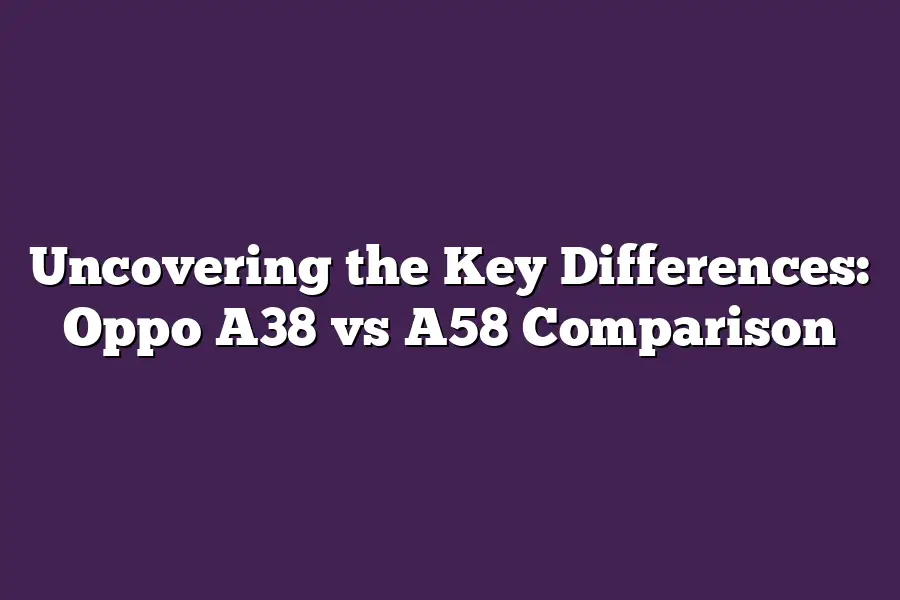Oppo A38 and Oppo A58 are both Android-based smartphones, but they differ in several key aspects. The primary distinction is that Oppo A38 has a dual-core processor, whereas Oppo A58 features a quad-core processor, providing enhanced performance and efficiency. Additionally, the A58 boasts 2GB of RAM, compared to 1GB on the A38. These upgrades contribute to improved multitasking capabilities and overall user experience.
As a long-time tech enthusiast, Ive always been fascinated by the subtle yet significant design choices that set one smartphone apart from another.
When it comes to Oppos A38 and A58 models, the differences are more than just skin deep.
As someone whos had the pleasure of putting both devices through their paces, I can confidently say that these phones represent two distinct approaches to mobile innovation.
While the A38 embodies sleekness and agility, the A58 exudes premium power and sophistication.
In this post, well dive into the nitty-gritty details of what sets these Oppo smartphones apart, from their display features to their processing prowess, camera capabilities, and storage solutions.
Whether youre a casual user or an avid gamer, understanding these differences will give you the edge you need to make an informed decision about which device is right for you.
Table of Contents
Design and Display: Where Form Meets Function
When it comes to smartphones, design matters - a lot.
You want your device to look great in your hand, but you also need it to feel premium and durable.
In this section, were going to dive deep into the design differences between Oppos A38 and A58 models.
Sleek vs Premium: A38’s Slim Build vs A58’s Angular Design
First off, lets talk about the aesthetics.
The Oppo A38 boasts a sleek and slim build thats perfect for those who prefer a phone that fits comfortably in their pocket.
With its slender profile and rounded edges, the A38 looks like a high-end device without breaking the bank.
On the other hand, the Oppo A58 takes a more premium approach with an angular design thats sure to turn heads.
The A58s sharper lines and chamfered edges give it a rugged, industrial look thats perfect for those who want their phone to stand out.
Display Showdown: HD+ vs FHD+
Now that weve covered the design differences, lets get into the nitty-gritty of display features.
The Oppo A38 sports a 6.2-inch HD+ screen with a resolution of 720 x 1600 pixels.
While it might not be the most impressive display on the block, the A38s screen gets the job done - perfect for casual browsing and gaming.
In contrast, the Oppo A58 takes the display game to the next level with a 6.5-inch FHD+ screen featuring a resolution of 1080 x 2400 pixels.
Thats a significant jump in terms of pixel density and overall image quality.
The A58s display is perfect for watching videos, playing graphics-intensive games, or simply scrolling through social media feeds.
Brightness, Color Accuracy, and the User Experience
So how do these differences affect the overall user experience?
Well, let me tell you - it makes a big difference!
With the Oppo A38s HD+ display, youll get a decent viewing experience, but it might not be as immersive or engaging as what the A58 has to offer.
The A38s screen is more suited for casual use cases, whereas the A58s FHD+ display is perfect for those who want a premium visual experience.
In conclusion, the design and display differences between Oppos A38 and A58 models are significant - but thats what makes them so appealing to different types of users.
Whether you prefer a sleek and slim build or a more angular design, theres an Oppo phone out there for everyone.
And with displays ranging from HD+ to FHD+, you can choose the perfect device to suit your visual needs.
Performance and Battery Life: Uncovering the Key Differences Between Oppo A38 and A58
As we dive deeper into the world of smartphones, its essential to understand what sets them apart.
In this case, were pitting the Oppo A38 against its slightly more powerful sibling, the Oppo A58.
Lets see how their processors and battery life fare in our performance and battery life showdown.
The Processor Showdown: Quad-Core vs Octa-Core
When it comes to processing power, the Oppo A38 is equipped with a quad-core processor, while the A58 boasts an octa-core processor.
On paper, this might seem like a significant difference, but lets look at the clock speed and RAM allocation to get a better understanding.
The Oppo A38s quad-core processor runs at a respectable 1.4GHz, backed by 3GB of RAM.
While this might not be the most powerful combo, its sufficient for everyday tasks like browsing, social media, and messaging apps.
In contrast, the Oppo A58s octa-core processor hums along at 2.0GHz, with a generous 4GB of RAM.
This significant boost in processing power will undoubtedly lead to smoother performance and faster app loading times.
Battery Life: A38 vs A58 – The Verdict
Now that weve covered the processors, lets turn our attention to battery life.
The Oppo A38 packs a 3,500mAh battery, while the A58 is equipped with a more substantial 4,200mAh power pack.
But how do these batteries perform in real-world scenarios?
The Oppo A38s 3,500mAh battery will likely provide a full day of moderate use, with some juice to spare for the next morning.
However, if youre a heavy user who likes to stream videos or play games on the go, you might find yourself needing to recharge more frequently.
In contrast, the Oppo A58s 4,200mAh battery will easily last two days of moderate use, and possibly even three with lighter usage.
This significant boost in battery life makes the A58 an excellent choice for users who are always on the move.
The Bottom Line: How These Differences Impact Performance and Daily Usage
So, how do these differences in processors and battery life impact overall performance and daily usage?
If youre a casual user who mainly uses their phone for social media, messaging apps, and occasional browsing, the Oppo A38 will likely be more than sufficient.
Its quad-core processor will handle everyday tasks with ease, and its 3,500mAh battery will provide a full day of moderate use.
However, if youre a power user who likes to stream videos, play games, or use resource-intensive apps on the go, the Oppo A58 is the clear winner.
Its octa-core processor and larger battery will provide a smoother performance and longer battery life, making it an excellent choice for those who need a phone that can keep up with their active lifestyle.
In conclusion, the Oppo A38 and A58 may share some similarities, but their differences in processors and battery life set them apart.
By understanding these key differences, youll be better equipped to choose the right smartphone for your unique needs and preferences.
Camera and Storage: The Battle for Photography Supremacy
When it comes to cameras, Oppo has certainly come a long way since its early days.
The A38 and A58, two of their most popular devices, have garnered significant attention from photography enthusiasts.
But what sets them apart?
In this section, well dive into the camera and storage features of these two devices, exploring how they cater to different needs.
Camera Capers: A Tale of Two Cameras
The Oppo A38 boasts a dual rear camera setup, comprising 13MP primary sensor and 2MP secondary sensor.
Not bad for a budget-friendly option!
The A58, on the other hand, takes things to the next level with its quad-camera arrangement featuring a 48MP primary sensor, an 8MP ultra-wide-angle lens, a 2MP macro lens, and a TOF (Time-of-Flight) camera.
Yes, you read that right - four cameras!
Now, lets get down to business.
When it comes to optical zoom, the A58 has got this covered with its 2x optical zoom capability, allowing for more flexibility when capturing distant subjects.
The A38 can only muster a digital zoom, which, as we all know, is a far cry from the real deal.
Portrait mode enthusiasts will also notice the difference.
While both devices support portrait mode, the A58s quad-camera setup provides a more detailed and nuanced bokeh effect, thanks to its advanced depth-sensing capabilities.
Low-light performance is another area where the A58 shines, leveraging its higher megapixel count and larger sensors to produce cleaner, less noisy images.
Storage Showdown: Where Does Your Data Live?
Storage options are another crucial aspect of any smartphone.
The Oppo A38 comes with 32GB internal storage, which can be expanded up to 256GB via microSD card.
Not bad, but not impressive either.
The A58 takes a different approach, offering 128GB internal storage and dedicating separate storage for apps and files.
This means youll have more space to store your precious memories (or cat videos) without worrying about running out of room.
And with the option to expand up to 256GB via microSD card, theres no shortage of storage for those who require it.
The Verdict: A Tale of Two Devices
So, which device is right for you?
If youre a photography enthusiast on a budget, the Oppo A38 might be the way to go.
Its dual rear camera setup and expandable storage options make it an attractive choice for casual photographers.
On the other hand, if you prioritize storage capacity or want the latest and greatest in camera technology, the Oppo A58 is likely your best bet.
With its quad-camera setup, dedicated storage, and advanced low-light performance, this device is a powerhouse for photography enthusiasts and data hoarders alike.
In conclusion, the Oppo A38 and A58 may seem like similar devices at first glance, but their camera and storage features set them apart in significant ways.
Whether youre a photography newbie or an avid shutterbug, understanding these differences can help you make an informed decision about which device is right for you.
Final Thoughts
As I wrap up this comparison of the Oppo A38 and A58, one thing is clear - each device caters to a unique set of needs.
While the A38 excels in terms of portability and affordability, the A58 shines with its premium design and impressive camera capabilities.
Whether youre looking for a budget-friendly option or a high-end device that checks all the boxes, this comparison has hopefully given you the insights you need to make an informed decision.
For me, this comparison was a reminder that theres no one-size-fits-all approach when it comes to choosing a smartphone.
Its about understanding your priorities and finding a device that aligns with them.
And in the end, thats what makes the world of smartphones so exciting - the endless options and opportunities for discovery.

